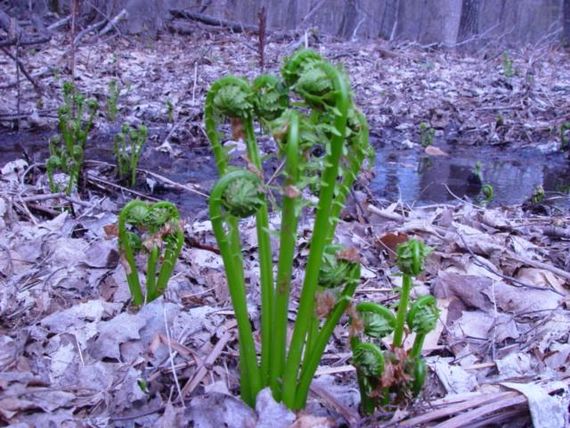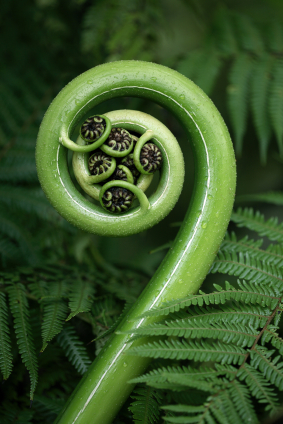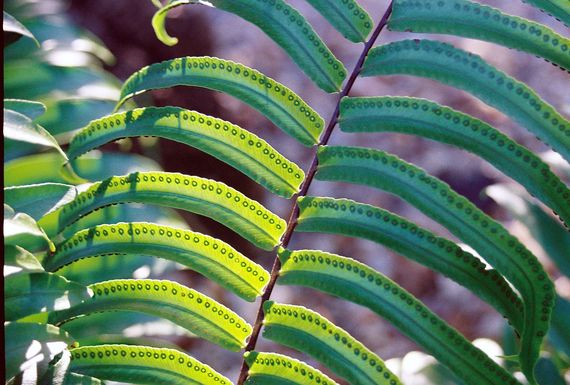History, Healing, Symbolism and More of Our Beloved Fiddlehead Fern
Beautiful article by Catherine Boeckmann addressing the history, healing and symbolism among cultures of our beloved fiddlehead fern:



A beautiful fern in the fern garden at Como Park in Minneapolis. Jasanna Czellar
Ferns are fascinating! This ancient family of plants—which lived BEFORE dinosaurs walked the Earth—has a prominent place in folklore and legend. Discover fern symbolism, healing powers, growing tips, and even recipes for cooking the young fiddlehead fern!
WHAT ARE FIDDLEHEADS?
In April, young ferns sprout from wet soil here in New Hampshire, appearing bright green against the decaying leaves. These are the fiddleheads, so-called because the very tops—furled tight when young—look like the tuning end of a fiddle.
Fiddlehead ferns are the popular name for Ostrich ferns (Matteuccia struthiopteris) which grow in central and eastern North America. Ferns require liquid water to reproduce, so you’ll often find them near streams and moist, forested areas.
Many Native American tribes would harvest fiddleheads, and they are even commercially harvested in the spring in Canada and New England.

Photo: “Ostrich Fern/ Fiddleheads” by Almanac reader Diane Peck

Photo: “Ostrich Fern/ Fiddleheads” by Almanac reader Diane Peck
COOKING WITH FIDDLEHEADS
Have you ever eaten fiddleheads? Many readers say it tastes like a cross between asparagus, baby spinach, and artichoke. It has a grassy, spring-y flavor with a touch of nuttiness. Fiddleheads are a very healthy green tonic, packed with antioxidants, omega acids, iron, and fiber.
Caution: In North America, it’s only the ostrich variety that is harvested; it grows in central and eastern part of North America. Fiddleheads must be picked before the fronds open to be edible. Each fern plant will produce several tops that turn into fronds. It’s best to take only half the tops per plant so they grow back. If you aren’t clear on how to forage, visit your local green grocer. They’re only available fresh or a few weeks in springtime, but they’re also sold frozen and canned.
Many people in this area cook the young fiddleheads for an asparagus-like treat. They need to be cooked thoroughly before eating. Although they’re not identified as toxic, it’s a safe precaution. Remove the husk, wash three times in cold water, and then either boil for 15 minutes or steam lightly in a steam basket for 10 to 12 minutes, just until tender crisp.
For more directions on how to cook, see the below fiddleheads recipes from the Almanac archives:
Spring Fiddleheads
Dijon Fiddleheads
Trout and Fiddleheads
Fiddleheads Mimosa
River Catfish With Fiddleheads and Potatoes
Risotto With Fiddleheads and Morels
Fiddlehead Soup (see photo below)
Dijon Fiddleheads
Trout and Fiddleheads
Fiddleheads Mimosa
River Catfish With Fiddleheads and Potatoes
Risotto With Fiddleheads and Morels
Fiddlehead Soup (see photo below)

A LITTLE FERN HISTORY
Ferns first show up in fossil records from a time over 100 million years BEFOREdinosaurs walked the Earth. In fact, ferns grew before flowering plants existed. There are thousands of species from those which are a few inches tall to others which resemble trees.
Long ago, people couldn’t explain how ferns reproduced since they lack flowers or seeds. Fern seeds were thought to make one invisible!
Today we know that ferns truly don’t have flowers or seeds. How do they reproduce? They have “spores.” With sunlight and photosynthesis, the spores grow into what is called gametes which are able to fertilize the sperm and start to move it into the fern plant. This is completely different than anything that happens with any other sort of flower! No wonder people were confused.
It was this mystery of the non-flowering fern that led to folklore about mystical flowers as seeds.
MIDSUMMER EVE LORE
During the Middle Ages, ferns were thought to flower and produce seed only once a year—at midnight on St. John’s Eve (June 23) prior Midsummer’s Day. Traditionally, this was a celebration accompanying the summer solstice.
- Since the seeds couldn’t be seen, they were believed to be invisible. According to lore, they could only be found once a year on St. John’s Eve (June 23), also called Midsummer Eve. The possessor of these “seeds” could understand the language of birds, find buried treasure, and have the strength of forty men.
- This folklore is also intertwined with Midsummer Day (June 24); bathing in the dew on this morning was said to bring youthful glow and healing.
FERNS FOR HEALING
Historically, ferns have been an important source of medicine for various ailments, especially for ancient tribes.
- The spores on the underside of the fern provide relief to the stinging nettle (which is often nearby).
- When boiled in oil or fat, Ophioglossum vulgatum has been used for wounds and to reduce inflammation.
- A poultice or lotion made from the roots of Botrychium. virginianum has been applied to snakebites, bruises, cuts and sores in the Himalayas.
- The powdered rhizomes of Adiantum lunulatum has been used as an antidote to snakebite in India.
- Extract of fresh leaves of Nephrolepis cordifolia has been used to stop bleeding of cuts and help in blood coagulation.
- The paste of the leaf of O. reticulatum has been applied to the forehead to get rid of headache.
- Filtered water extract of rhizome of Abacopteris multilineata has been used for stomach pains.
FERN SYMBOLISM
The ancient fern has a history rich in symbolism. As mentioned above, ferns were seen as good luck, often for new lovers. The fern symbolizes eternal youth.

- To the indigenous Maori of New Zealand, the fern represented new life and new beginnings.
- To the Japanese, the fern symbolizes family and the hope for future generations.
- According to Victorians, the fern symbolized humility and sincerity. Click to see the meaning of plants and flowers.
GROWING FERNS
People love ferns, whether they grow them in their yard or as houseplants.
If your yard has indirect sunlight and moist soil, consider growing ferns outdoors. They are one of the more deer-resistant plants, too. This page includes a list of native ferns in North America.
As houseplants, common ferns are the Boston Fern and the Staghorn Ferns.
- Boston ferns grow well with temperatures that are 68 to 75 degrees F during the day and 50 to 69 degrees F at night. They require humidity between 50 and 80 percent, and they do not like drafts. Boston ferns stop growing from fall to winter and during this dormant stage like the temperature to be 50 degrees, minimal watering (the soil should be barely moist), and no fertilizer. During the winter, mist the leaves twice a day. The fern’s root system can occupy up to three quarters of the solid space in the pot without harm, and this plant does not like to be repotted.
- Staghorn ferns are often presented as gifts. They can not be planted in ordinary potting soil, so that’s the first thing to check. They should be placed on a piece of bark or (unreated) wood board. Place a few handfuls of damp sphagnum moss or orchid mix on the board and place the fern on top so that the flat round basal fronds are touching the board. Firmly secure the fern to the board with twine, a thin wire, or fishing line. (The fern will attach itself to the wood eventually.) To water staghorn fern, soak the entire arrangement in a bucket or sink. Keep the fern in the shade and water daily until it takes hold of the wood. Feed every two weeks year-round with a balanced liquid fertilizer diluted by half.
I hope you discovered something new about the humble fern.


